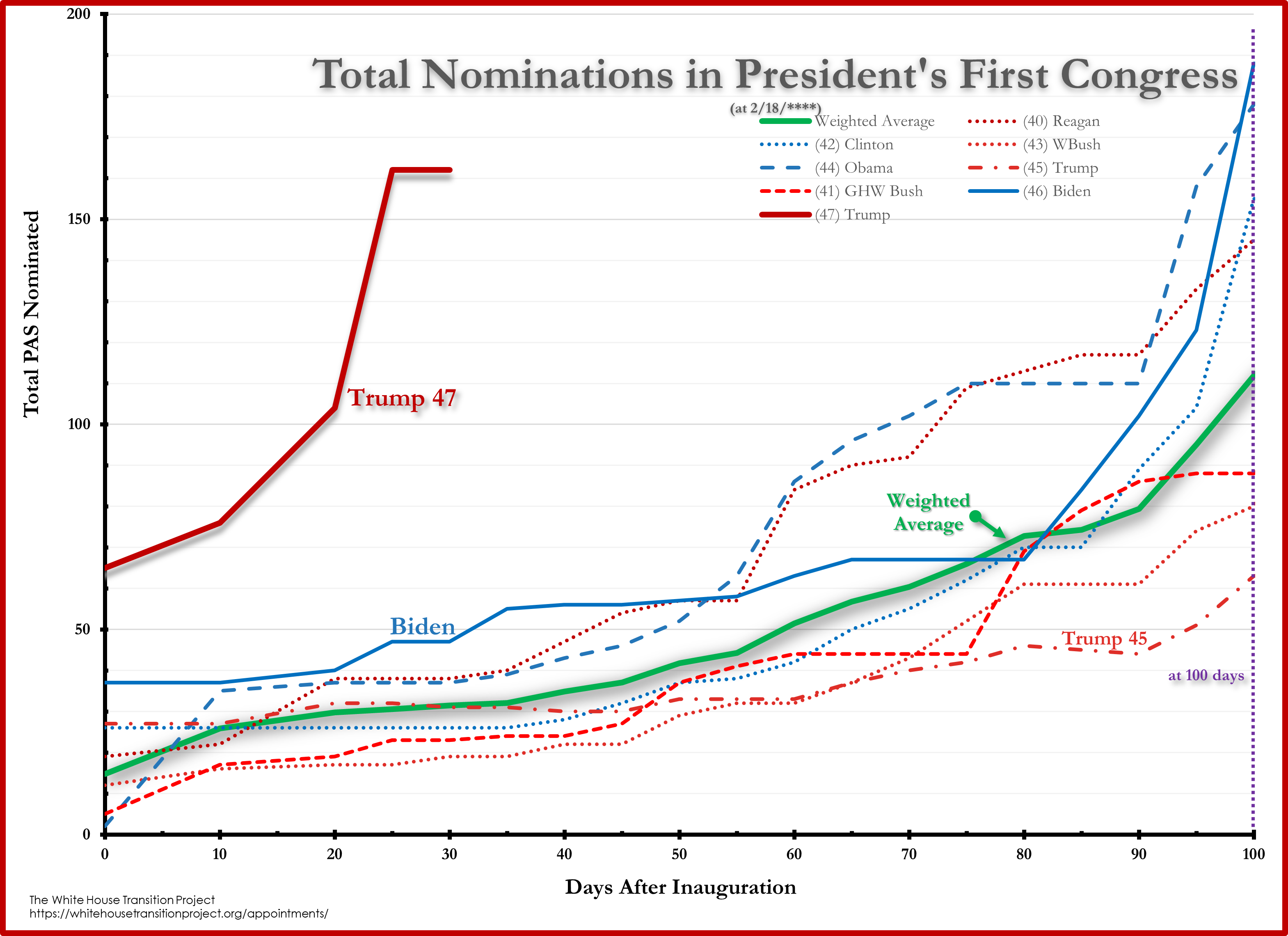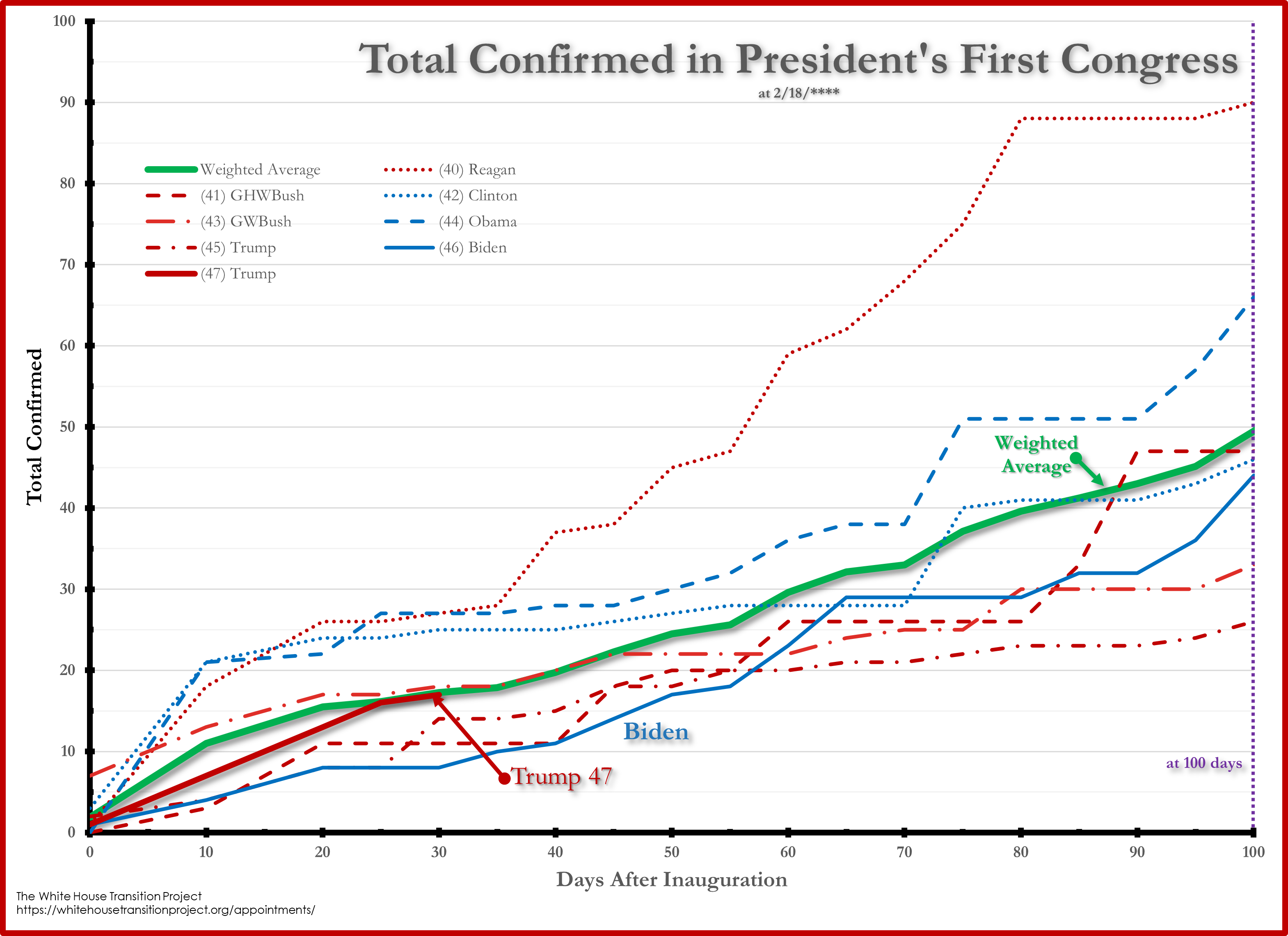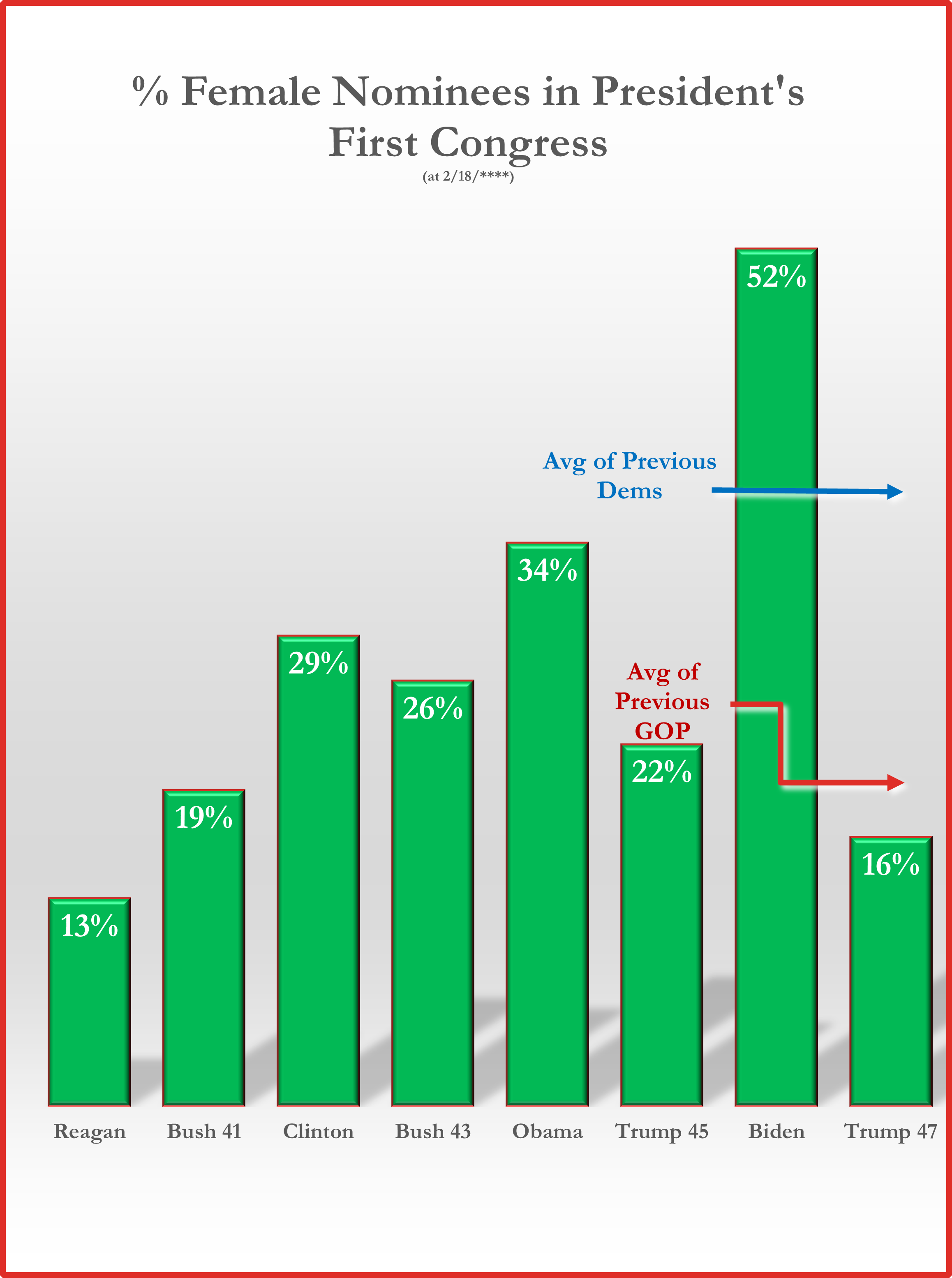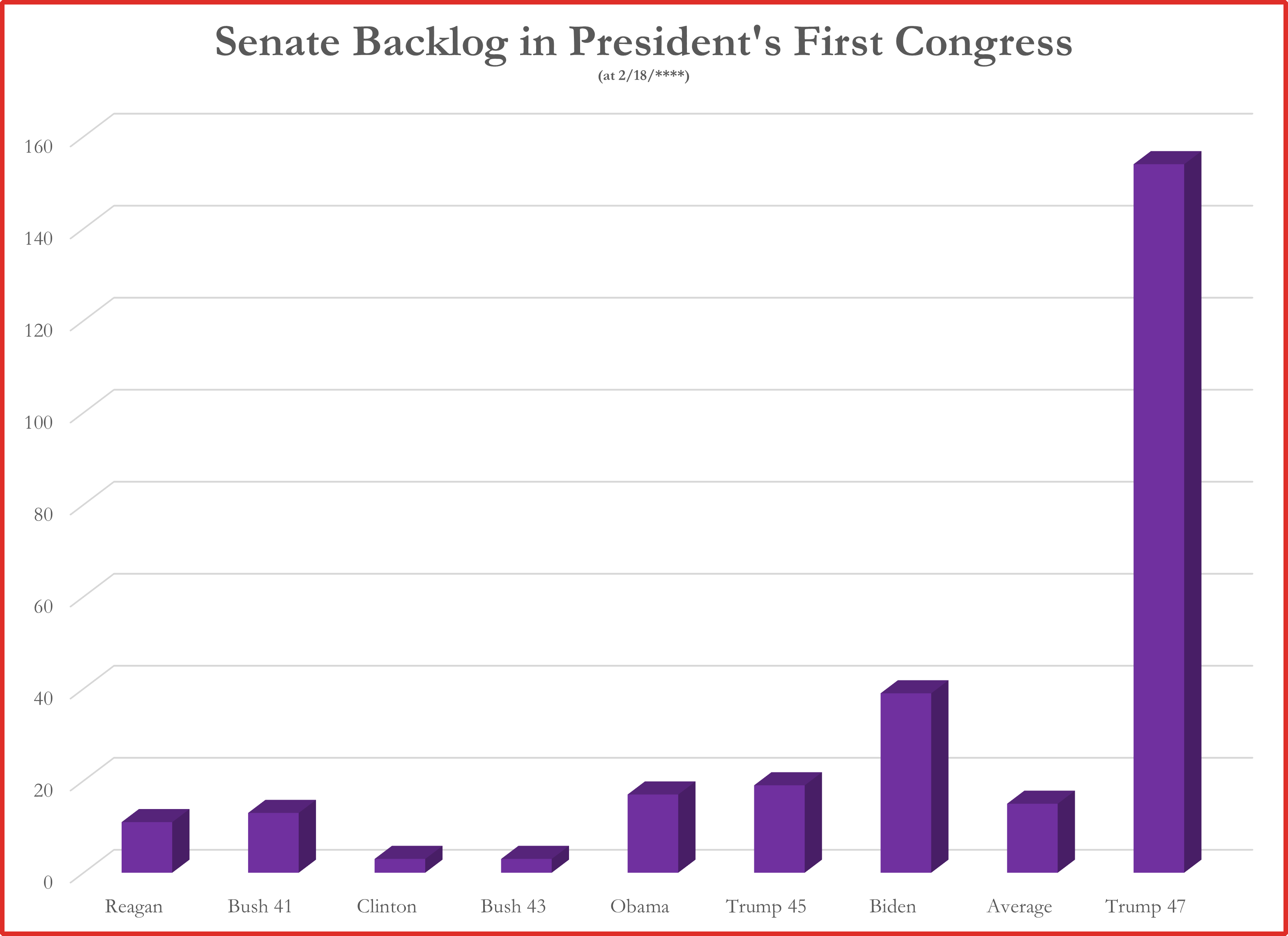WHTP’s Useful Resources
- Current Resource: Plumbook 2024.
- WHTP’s Original Scholarly Research: The Nuclear Option Fizzled…again. A scholarly journal article on the effects of using the Senate’s “nuclear option” on judicial appointments, examining all instances of reforms since 2013. The results suggests that how leaders control the Senate’s policy agenda matters more than does the partisan polarization that all of the nuclear options aimed to fix.
The Longer You Wait, The Longer It Takes. A scholarly journal article on the impact of transition planning, presidential initiative, and “stand-up critical” positions on the pace of appointments. Analyzing 3,000 nominations over the last 40 years, and within a complex empirical model invoking the effects of other standard variables predicting deliberations, including various measures of polarization. These critical, transition variables counteract the effect of polarization. - WHTP Summarizes Scholarly Knowledge: A WHTP Memo on Appointments Politics summarizes recent scholarship on appointments.
Summaries from Appointments Analyses
At Day 30 (2/18/2025)
This page provides documents the pace of appointments in the current presidential transition and by comparison with predecessors in the modern appointments era (beginning with the Reagan presidency). See basic descriptions here.
Headlines
-
- Backlogs: The Senate faces a large number of presidential nominees.
- On Nominations: While the Biden transition produced the best performance since transition records at 100 days, the new Trump 47 White House has flooded the Senate with nominations.
- On Confirmations: (and hence on filling policy leadership positions), the Trump administration’s volume now presents an historically large backlog.
- On Gender: The Trump administration has nominated almost exclusively male nominees with only 16% of its nominees are women.
Pace of Nominations – rebounding to its earlier pace but still below the leaders.
 This figure reports the record of nominations for the past seven presidential administrations to provide a comparison with the Trump administration’s pace of nominations. The average administration (green solid line) stands well below the Trump performance.
This figure reports the record of nominations for the past seven presidential administrations to provide a comparison with the Trump administration’s pace of nominations. The average administration (green solid line) stands well below the Trump performance.
Pace of Confirmations – normal
 Poor and stalled out. The situation on confirmations remains just at the average.
Poor and stalled out. The situation on confirmations remains just at the average.
The Backlog – record setting backlog
In the Senate, receiving a nominee results in a referral to a committee of jurisdiction which starts the Senate’s vetting. And here things start to go off the rails. This first Senate stage (indicated with light tan on the graph) ends with a committee report to the full Senate or when the full Senate “discharges” its committee of further deliberations, which then starts a clock on how long the Senate goes before it makes a final and official decision (the dark tan bar).
What’s This Delay About? The typical wisdom on Senate delay highlights partisanship and the Senate’s myriad mechanisms for following “courtesy,” which infuses a trickle of partisan delay into the system. Recent scholarship on appointments by the White House Transition Project, however, has highlighted the importance of the policy agenda in affecting both the pace of White House and Senate business in determining its deliberations on appointments. “We tend to consider appointments as a separate thing, set apart from the rest of Senate business,” notes Terry Sullivan, WHTP’s executive director and an expert on appointments, “but appointments are just part of the larger policy making process, so the pace of appointments significantly reflects what else is before the government.” That research concludes that the greater the demands on the Senate for policy making the less the time to spend on appointments. “In effect, the Senate can’t walk and chew gum at the same time.”
So the Senate workload has two kinds of consequences for appointments. First, more workload detracts from the time Senators have to concentrate on vetting and considering appointments. Ninety days into a typical administration and the Senate would have just begun considering the president’s and the typical policy agenda. But for President Biden, the Senate has already wrestled with a presidential impeachment trial, an attempted coup, an ongoing public health disaster, an economic collapse mirroring the Great Depression, and passage of two historically massive spending programs. Delay on those grounds alone would be inevitable says the research.
Second, policy making increases the likelihood that Senators will use nominees as pawns in a completely unrelated game. For example, Texas Senator Ted Cruz (R) has already threatened to slowdown two Biden nominees for the State Department to highlight his own opposition to a gas pipeline deal between Russia and Germany, even though the Biden administration has already announced it opposed the same pipeline and had already placed sanctions on the Russian actors involved. The threat of delay on these nominations clearly has little to do with the two nominees by comparison with whatever it is Senator Cruz wants to promote.
In addition, the agenda can affect the decision process in the White House as well, delaying nominations to concentrate on policy making and a growing agenda along with essentially crisis management carrying out new initiatives. Since the inauguration, for example, the Biden White House has produced fewer new nominations as the average of his six predecessors: 32 to 35 respectively.
Pace on Gender
 Candidate Trump promised an administration that reflects the old days determined by “competent white men.” On gender, he has set records with his appointments. By comparison with his Democratic predecessors, Trump’s nominees falls below every other President back to the 1980s, a rate 60% below that of Biden and the average for Democrats and 30% below that for Republicans.
Candidate Trump promised an administration that reflects the old days determined by “competent white men.” On gender, he has set records with his appointments. By comparison with his Democratic predecessors, Trump’s nominees falls below every other President back to the 1980s, a rate 60% below that of Biden and the average for Democrats and 30% below that for Republicans.
For questions or commentary, contact: Terry Sullivan, WHTP, at sullivan@ibiblio.org or 919-593-2124
Appointments Pace Trackers – Description
Return to top
The White House Transition Project documents the pace at which a new administration fills out the American executive branch through its appointments power. WHTP tracks the pace of appointments in four ways.
A Focus on PAS Positions. First, we track 980 presidential appointments requiring Senate confirmation (known as “PAS” positions). These appointments include top administration positions in all the cabinet agencies (e.g., the Deputy Secretary for Commerce), the top positions in the independent regulatory agencies (e.g., member of the Board of Governors of the Federal Reserve), and the top positions in the myriad of government boards and commissions (e.g., member of the Chemical Safety and Hazard Investigation Board). WHTP tracks the most important ambassadorships (e.g., Israel, UK, NATO, Russia, China) but we do not track all ambassadors, US Marshals, or most federal attorneys, though all these also require Senate confirmation. Also, note, technically the largest group of PAS positions are uniformed military officers. We don’t track them either.
The Pace of Institutional Deliberations. Second, WHTP follows the vetting processes both in the Executive and the Senate, detailing how long each takes to move a nomination along. In the Executive, we track from the White House announcement of an “intent to nominate” and then compare that when the executive forwards nominee’s packet to the Senate. This period typically involves the pace of ethics and security screening. In the Senate we track how long a nomination stays in the relevant Senate committees and then how long the nomination remains on the Senate’s calendar leading to the floor decision on confirmation. Note, in the modern era, if the Senate votes, it confirms virtually all nominations. Administration “failures” either get withdrawn or they simply languish in committee.
Standing UP the Leadership on Critical Duties. Third, WHTP identifies and tracks positions critical to national responsibilities. Based on a collaboration with the National Commission to Reform the Federal Appointments Process, WHTP has identified 274 stand-up critical (or “time sensitive”) leadership positions. These positions include all the leadership in government agencies (i.e., Secretary, Deputy Secretary), national security (e.g., Director FBI, Assistant Treasury Secretary for Terrorist Financing), economic management (e.g., Deputy US Trade Representative), critical management positions (e.g., General Counsel, Department of Veterans Affairs), and those key to the management agenda (e.g., Deputy Director of OMB, Inspectors General). Successfully filling out these positions “stands up” the American executive.
Measuring the Pipeline of Nominations and Confirmations. While nominations move along the process from identification to vetting to nomination to consideration to confirmation, a nominee moves through the hands of executive and senate staff and decision-makers both in the White House and the Senate. Presidential Personnel identifies potential nominees and later turns those over to the White House Counsel and the security and ethics agencies to look into a nominee’s background. Meanwhile the Personnel Office moves on to the next challenge. In the Senate committees and staff take similar, early responsibilities and turn their deliberations over to the full Senate. So, the appointments process is a group nominees and decisions and a pipeline process. WHTP assesses the pipeline as well in two ways: 1) how many nominees have secured the President’s “intent to nominate” (as a measure of the backlog of nominees) and how many eventual nominees await a final Senate decision (as a measure of Senate backlog). We take the average in each as an assessment of the vitality of the Executive and Senate processes.

